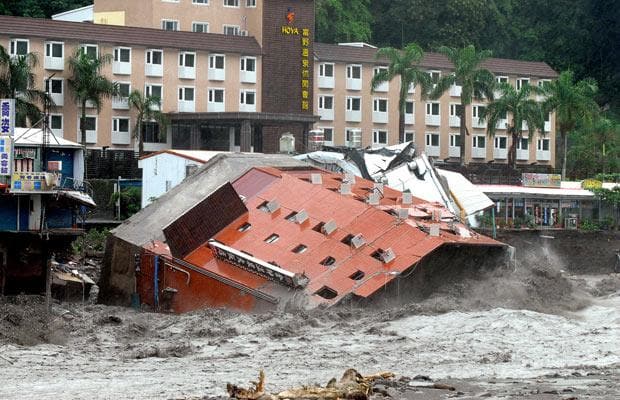
China Gambles on the Media Market
October 14, 2009
Rudd’s Rebuff
October 16, 2009By: Project 2049 Institute |
A visit to Taiwan every couple of months is needed to remind oneself of a world that exists outside the ordinary comforts of northern Virginia. The beauty and rich complexity of Taiwan can be mesmerizing. Yet a major typhoon that lingered off the southern coast of Taiwan, a 6.3 magnitude earthquake, and an extravagant Chinese military parade earlier this month are stark reminders of the diverse range of threats that the island’s population faces. Not for the weak of heart, Taiwan is the most dangerous place on earth. Here’s a condensed review of the threats to lives, property at the local level, and overall economic and political stability that Taiwan’s democratically-elected government must manage.
Natural Disasters
A 2005 World Bank report assessed that “Taiwan may be the place on Earth most vulnerable to natural hazards, with 73 percent of its land and population exposed to three or more hazards.†Trends indicate the threat from natural disasters may be getting worse. Perhaps a direct result of global climate change, insurance claims due to natural disasters have experienced a dramatic rise over the past several years.
- Typhoons. Typhoons make up at least 70% of Taiwan’s natural disasters.Taiwan is highly sensitive to climate change, specifically warming ocean temperature, which is believed to increasing the number and/or intensity of typhoons.The island is affected by four to six per year, each resulting in various degrees of loss of life and economic damage.
- Floods and Landslides. With some of the sharpest drops in elevation in the Asia-Pacific region and frequency of typhoons, Taiwan is particularly vulnerable to floods and landslides.Typhoons and tropical storms can result in a major amount of rain in a very short period.For example, Taiwan averages about 2500 millimeters of rain each year.However, Ilan County absorbed almost 1500 millimeters of rain over the last four days alone.
- Earthquakes. Earthquakes can intensify the threat of floods and landslides.On of the world’s most seismically active spots on earth, the island of Taiwan is a collision zone between the Philippine Sea and Eurasian tectonic plates. More than 200 earthquakes can felt on the island every year. More than 3000 perished in an earthquake in the 1930s, and the Chi-Chi earthquake that struck on September 21, 1999 claimed 2500 lives. In addition to occasional failures of its critical information infrastructure, Taiwan’s average annual loss due to 83 disastrous earthquakes since 1900 equals about 0.7% of Taiwan’s annual gross domestic product (GDP).
- Tsunamis. Earthquakes with epicenters near or in the sea can generate tsunamis along the coast of Taiwan. In fact, before the 2004 tsunami, Taiwan often is credited with suffering the greatest losses from a tsunami in the Western Pacific (see the U.S. National Geophysical Data Center report here). Many in Taiwan’s scientific community have called for fielding a system capable of providing early warning of off-shore seismic and other events, perhaps linking in to the Pacific Tsunami Warning Center in Hawaii.
Pandemics
The military and natural disaster threats are serious. However, most threatening may be pandemics. Widespread urbanization, high population density, proximity and travel to and from the historical source of most of the world’s most severe pandemics (China) indicate that a pandemic may be Taiwan’s most severe threat. A key reason for the high risk of pandemic in Taiwan is its population density, which is the second highest in the world among countries with a population of more than 10 million.  One study indicated that if an influenza outbreak similar in scale to that of 1918, casualties could reach 315,000.
Terrorism
Taiwan often is viewed as immune to terrorism, perhaps due to the island’s isolation within the international community. Yet the unexpected often happens. Taiwan’s role as a hidden center of the global economy and the open nature of its society could someday lead to the unthinkable. The island’s ports have been viewed as a potential transshipment point for weapons of mass destruction. Taiwan has been a active participant in U.S.-led global counter-proliferation initiatives, such as the Megaports Project.
Use of Military Force
Taiwan faces the most daunting military challenge in the world. As highlighted in the March 2009 Department of Defense Report to Congress on Military Power of the People’s Republic of China (PRC), “China’s armed forces are rapidly developing coercive capabilities…[that] could in the future be used to pressure Taiwan toward a settlement of the cross-Strait dispute on Beijing’s terms while simultaneously attempting to deter, delay, or deny any possible U.S. support for the island in case of conflict.â€Â  Complicating matters is the uncertainty in Taipei about the U.S. security commitment to Taiwan and America’s role as security guarantor in East Asia.
Summing It Up: The Evolving All-Hazards Approach
To make matters worse, the Republic of China (Taiwan), despite its meeting almost every legal criteria for sovereignty, does not enjoy diplomatic recognition from most of the international community. Despite its nascent democracy, Taiwan’s international diplomatic status often falls below thug states like North Korea, and international entities like the Palestinian Liberation Organization and the Vatican.
In light of the range and severity of threats and its diplomatically-challenged international status, Taiwan has done fairly well over the last 10 years in coping with its diverse security challenges. A visit in early October to Taiwan’s activated Central Emergency Operations Center during the most recent typhoon demonstrated a professionalism and competency that was refreshing, and put the extremely unfortunate bureaucratic snafu that delayed central government response to Typhoon Morakot in August 2009 in a different light. As in war, Clausewitzian friction stems from imperfect situational awareness, which in turn results in imperfect responses.  Friction is the unexpected. It is also Murphy’s Law — if it can go wrong, it will.
Rarely if ever is there an emergency – manmade or otherwise – in which human frailties and imperfections aren’t exposed.  However, improvement comes from learning. Because it has much more experience than we do, there’s a lot the United States could learn from Taiwan’s evolving “all-hazards†approach to emergency management.




